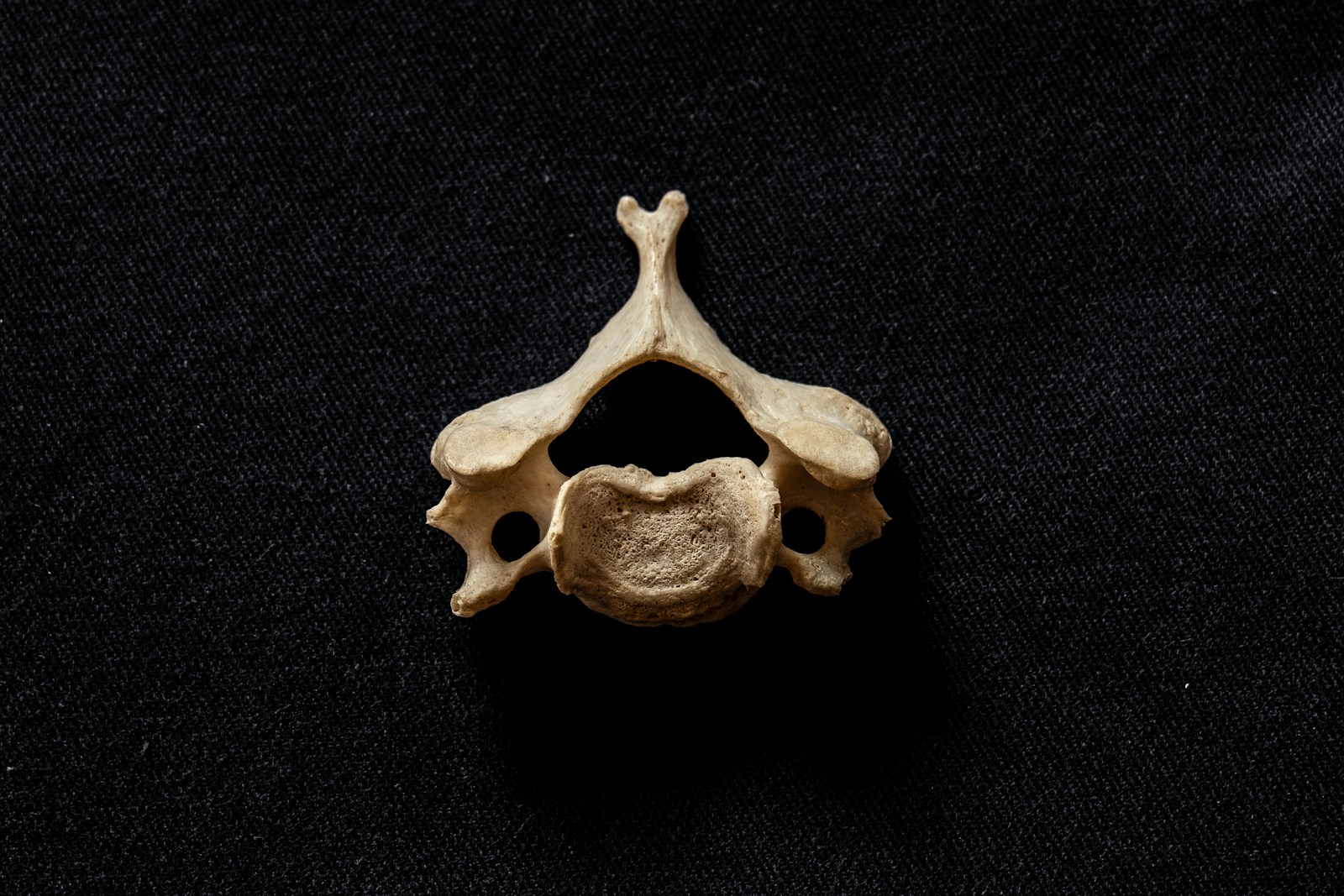The cervical vertebrae, consisting of seven unique bones, form an essential part of our vertebral column, providing both support and mobility for the neck. Their intricate structure, including intervertebral discs, joints, and ligaments, demonstrates an evolutionary masterpiece of balance between stability and flexibility. Remarkable features like bifid spinous processes and transverse foramina further distinguish the cervical vertebrae, underlining their role in head movement and spinal cord protection. This begs the question, how does the complex design of the cervical vertebrae influence our understanding of posture, movement, and spinal health?
Understanding Cervical Vertebrae
The cervical vertebrae, constituting a critical component of the human vertebral column, are a set of seven individual bones that are meticulously arranged in a highly structured manner, serving the indispensable function of providing support and mobility to the neck region. The strategic placement and orientation of these vertebrae have evolved over millions of years, resulting in an intricate structure that facilitates a broad range of motion.
Cervical vertebrae evolution has led to a design that effectively balances the dual demands of strength and flexibility. The first two vertebrae, the atlas and axis, display unique structural adaptations that allow for specialized movements such as nodding and rotation. The remaining five cervical vertebrae provide a flexible yet sturdy framework for the neck.
The benefits of neck flexibility are numerous. It allows for the essential movements of looking up, down, and to the sides, enhancing spatial awareness and interaction with the environment. Additionally, it enables the safe absorption and distribution of forces during physical activities, reducing the risk of injury. Besides, neck flexibility aids in maintaining balance and posture, underlining the critical role of the cervical vertebrae in overall bodily function and well-being.
Anatomy of the Cervical Spine
The cervical spine consists of a complex anatomical structure that serves as an essential component of the skeletal system. It is imperative to understand its structure, encompassing seven vertebrae, intervertebral discs, joints, and ligaments, to comprehend its functionality and the role it plays within the body. Moreover, a detailed analysis of potential spinal disorders will elucidate the clinical implications of abnormalities within this region.
Cervical Spine Structure
Comprising seven distinct bones, the cervical spine presents a complex anatomical structure pivotal to the support and movement of the head. This complexity is largely a result of vertebrae evolution, which has refined the balance between structural stability and mobility. Each vertebra is uniquely shaped to fulfill its role, with the cervical vertebrae being the smallest and most flexible.
Cervical biomechanics further illuminate the complexity of this region. The top two vertebrae, the atlas and axis, are specialized for rotation, allowing the head to turn. The remaining five vertebrae facilitate bending and flexing. Intervertebral discs and facet joints allow for controlled movement, while the vertebral foramen provides a protective conduit for the spinal cord. This intricate structure underlines the cervical spine’s critical function in head support and movement.
Understanding Spinal Disorders
Understanding the anatomy of the cervical spine is fundamental in diagnosing and treating various spinal disorders, as abnormalities or injuries in this region can lead to symptoms such as chronic pain, limited mobility, or neurological issues. Spinal surgery advancements have greatly improved the prognosis for patients suffering from these conditions, offering minimally invasive techniques that reduce recovery time and enhance overall outcomes. Equally important is acknowledging the role of nutrition in spinal health. Adequate intake of nutrients like calcium, vitamin D, and omega-3 fatty acids is key in maintaining the structural integrity of the cervical spine. Understanding these factors in conjunction to the cervical anatomy can enable clinicians to develop thorough, effectively treatment strategies for various spinal disorders.
The Role of Cervical Vertebrae
The cervical vertebrae, comprising the uppermost part of the spine, have a significant role with important implications for human health and function. The structure of these vertebrae is intricately designed to support the skull, enable diverse neck movement, and protect the spinal cord. However, their pivotal location and functionality also make them susceptible to a range of health issues, for which understanding their structure and function can guide effective solutions.
Understanding Cervical Vertebrae Structure
Cervical vertebrae, essential components of the spinal column, exhibit a unique structure tailored to their essential role in supporting the head and facilitating a range of complex movements. Comprising of seven vertebrae, denoted as C1-C7, they are distinguishable by their small size and the presence of foramina in their transverse processes. These foramina serve as conduits for vertebral arteries, ensuring adequate blood supply to the brain. The structural integrity of these vertebrae is pivotal, as vertebrae injuries can lead to debilitating conditions. Significantly, cervical osteoporosis, a condition characterized by the thinning of the vertebral bone tissue, can compromise the stability of the cervical region, increasing the risk of fractures and subsequent neurological complications. This underlines the critical importance of understanding the structure of cervical vertebrae.
Cervical Vertebrae Functionality
Having examined the structure of the cervical vertebrae, it is equally important to elucidate their multifaceted roles in human physiology. The functionality of the cervical vertebrae is vital for several reasons:
- Vertebrae Development: The cervical vertebrae are the first to form during fetal development, providing a foundation for subsequent spinal growth. They play a significant role in establishing the neck’s mobility and flexibility.
- Support and Movement: They support the weight of the head and facilitate its wide range of movements, including rotation, flexion, and extension.
- Protection: They protect the spinal cord and associated nerves, serving as a conduit for nerve signals between the brain and the rest of the body.
Aging implications for cervical vertebrae include degenerative changes, which can compromise these functions and lead to potential health issues.
Health Issues and Solutions
In the domain of spinal health, an assortment of conditions can afflict the cervical vertebrae, prompting the need for a variety of clinical interventions and solutions. Conditions such as cervical spondylosis and herniated discs are commonly exacerbated by the vertebrae aging process and can result in chronic pain or even loss of function.
Cervical vertebrae nutrition is a critical strategy in preventing and managing these conditions. A balanced diet sustains the vertebrae’s structural integrity and facilitates their repair. Nutrients such as calcium, vitamin D, and omega-3 fatty acids are essential for maintaining the health and functionality of the cervical vertebrae.
Thus, a multi-pronged approach, combining nutritional intervention, physical therapy, and possibly surgical treatment, is often necessary for managing health issues related to cervical vertebrae.
Unique Features of Cervical Vertebrae
Distinctive characteristics distinguish the cervical vertebrae from other vertebrae in the spinal column, contributing to their specific functionality within the vertebral system. These unique features have evolved over time, a process known as cervical vertebrae evolution, to adapt to the specific needs and demands of the cervical region.
Three main features set the cervical vertebrae apart:
- Bifid Spinous Process: Unlike other vertebrae, most cervical vertebrae possess a bifid, or split, spinous process. This split enhances muscle attachment, improving head and neck movement.
- Transverse Foramen: Each cervical vertebra has a transverse foramen which houses the vertebral artery, a key component in supplying blood to the brain.
- Small Body: The bodies of the cervical vertebrae are smaller than those of other vertebrae, reflecting the lesser weight they carry.
Cervical vertebrae are not immune to structural anomalies, such as vertebral fusion anomalies. These irregularities occur when two or more vertebrae fuse together, compromising the flexibility and functionality of the neck. Understanding these unique features and potential anomalies is critical in diagnosing and treating cervical spine disorders.

The Importance of Good Posture
The importance of maintaining proper posture is crucial to the health of the cervical vertebrae. Incorrect positioning can cause excessive strain on the spine, potentially resulting in long-term structural complications and discomfort. A thorough understanding of common postural errors, and the methodologies for their correction, is therefore essential for the preservation of spinal integrity.
Impact on Spinal Health
Maintaining good posture, an essential aspect often overlooked, greatly influences the health of the cervical vertebrae and, consequently, the overall spinal health.
- Spinal Mobility: Good posture improves spinal mobility, allowing a free range of movement and reducing the likelihood of pain or injury.
- Neck Flexibility: It also enhances neck flexibility, ensuring the cervical vertebrae can perform their functions effectively.
- Disc Health: Poor posture can exert extra pressure on the intervertebral discs, leading to premature degeneration.
Incorrect posture can negatively affect these important aspects, leading to chronic conditions such as cervical spondylosis. Therefore, understanding the importance of posture and implementing correct practices are crucial steps in maintaining excellent spinal health.
Correcting Posture Mistakes
Understanding the elements of correct posture is imperative in mitigating the detrimental effects of poor posture on the cervical vertebrae. Tech induced posture, a result of prolonged usage of devices, often leads to the forward head posture, straining the neck and spine. Corrective measures, in this case, should focus on promoting neutral alignment, reducing unnecessary pressure on the cervical vertebrae.
Posture accessories play a significant role in this correction. Ergonomic chairs and adjustable desks can help maintain spinal alignment, while posture correctors can provide necessary support. Regular breaks from screen-time, exercises targeting neck and shoulder muscles, and maintaining eye level with the device can also correct tech-induced posture. It is important to note that while these methods are beneficial, professional advice should be sought for a personalized approach.
Common Cervical Vertebrae Disorders
Cervical vertebrae disorders, inclusive of conditions like cervical spondylosis and cervical disc disease, represent a significant public health concern due to their prevalence and potential to severely impair quality of life. These disorders often result from Cervical Vertebrae Injuries, and their management involves the implementation of Healthy Neck Habits.
Cervical spondylosis, a degenerative condition, is commonly associated with aging. It results from wear-and-tear of the cervical spine, leading to chronic neck pain and stiffness. On the other hand, cervical disc disease involves the herniation or bulging of the cervical discs, causing nerve compression and consequent pain and numbness.
Three notable contributing factors to these disorders include:
- Poor posture: This creates unnecessary tension on the neck and can accelerate the wear-and-tear process.
- Occupational hazards: Jobs that involve repetitive neck movements or prolonged periods of sitting can increase the risk of developing cervical disorders.
- Trauma: Accidents or injuries can cause immediate damage to the cervical spine, or may lead to long-term problems due to inadequate healing.
Understanding these disorders is necessary for effective prevention and management strategies.
Recognizing Symptoms of Cervical Issues
A myriad of symptoms can present themselves when cervical issues arise, making it essential for individuals to recognize potential warning signs for timely intervention. The onset of cervical vertebrae injuries can lead to a spectrum of symptoms, ranging from mild discomfort to severe, incapacitating pain. Neck pain management becomes important at this juncture.
The most common symptom is persistent neck pain, often exacerbated by head movement or prolonged periods in a static position. This may be accompanied by stiffness or reduced range of motion in the neck, one of the telltale signs of a cervical disorder. Individuals may also experience headaches, particularly at the back of the head, which can be intermittent or constant.
In more severe cases, the discomfort may extend beyond the neck region, leading to numbness, tingling or weakness in the arms, hands or fingers. This is indicative of nerve impingement or spinal cord compression, both serious conditions requiring immediate medical attention. Additionally, some individuals may experience difficulty in maintaining balance or coordination, vertigo, or even symptoms of nausea.
Understanding these symptoms is the first step towards effective neck pain management and can aid significantly in preventing the progression of cervical vertebrae injuries.
Diagnostic Techniques for Cervical Problems
To accurately diagnose cervical issues, several sophisticated techniques are employed, each designed to pinpoint the exact nature and location of the problem. These techniques aid in identifying issues such as vertebrae misalignment and degenerative disc disease, both of which can cause significant discomfort and mobility problems.
- Imaging Tests: These are often the first diagnostic tools used. Radiographs, CT scans, and MRI scans provide detailed visuals of the cervical spine, enabling the identification of any structural anomalies, including vertebrae misalignment.
- Electromyograms and Nerve Conduction Studies: These tests assess the electrical activity in nerves and muscles, providing data on nerve function and communication. They can detect nerve damage or compression caused by vertebrae misalignment.
- Discograms: This invasive procedure involves injecting a contrast dye into the cervical disc to highlight areas of degeneration or damage. It’s especially useful in diagnosing degenerative disc disease.
These diagnostic techniques are essential in understanding the underlying issues causing cervical pain. The images and data generated provide a thorough view of the cervical spine’s condition, guiding the medical professional’s decisions on the appropriate treatment pathway.

Treatment Options for Cervical Disorders
Once a thorough diagnosis has been established, a range of treatment options can be explored, each tailored to address specific cervical disorders and alleviate the accompanying discomfort and mobility issues.
Cervical disorders can be treated using both conservative and invasive approaches. Conservative treatment often includes physical therapy and medications, such as analgesics and muscle relaxants. However, in severe cases where conservative treatments fail to provide relief, surgical interventions may be necessary. These can include procedures like discectomy, where the damaged disc is removed, or fusion surgery, which joins two or more vertebrae together to restrict movement and alleviate pain.
Alternative therapies have also been found to be effective in some cases. These can include acupuncture, chiropractic adjustments, and massage therapy. These treatment modalities aim to improve mobility, reduce pain, and enhance quality of life by relieving tension in the muscles and joints of the neck.
The selection of treatment largely depends on the severity of the disorder, the patient’s overall health, and their personal preference. Hence, a holistic and individualized approach to treatment planning is necessary for the best outcomes. An interdisciplinary team of healthcare professionals can provide a holistic approach to managing cervical disorders, integrating different treatment options to ensure thorough care.
Exercises for Cervical Health
In addition to medical treatments and alternative therapies, targeted exercises play a pivotal role in maintaining cervical health and managing symptoms of cervical disorders. These exercises primarily aim to improve flexibility, enhance strength, and restore normal function of the neck.
Incorporating cervical exercises into daily routines can help mitigate the risk of cervical disorders and improve overall quality of life. Three key exercises for cervical health include:
- Neck Stretch: This exercise involves gentle stretching of the neck muscles to relieve tension and enhance flexibility.
- Neck Strengthening: Regular strengthening exercises can build resilience in the cervical muscles, reducing the risk of injury.
- Posture Improvement: Maintaining a good posture is critical to keeping the cervical spine in proper alignment and avoiding unnecessary strain.
Cervical pillows usage is another important aspect of cervical health. These specially designed pillows support the natural curvature of the neck, thereby reducing stress on the cervical vertebrae during sleep.
Moreover, stress management techniques such as deep breathing, meditation, and yoga can also contribute to cervical health as they help in reducing muscle tension and promoting relaxation. Regular practice of these techniques can significantly improve cervical wellness and prevent the onset of disorders.
All these measures, when combined, can markedly enhance cervical health, thereby improving the overall wellbeing of an individual.
Maintaining Healthy Cervical Vertebrae
Building on the foundation of targeted exercises and stress management techniques, the maintenance of healthy cervical vertebrae requires a thorough understanding of their structure and function in our bodies. Equally significant is the role of cervical vertebrae nutrition that directly influences the health and resilience of these vital bones. A balanced diet rich in calcium, vitamin D and other essential nutrients promotes bone strength and prevents degenerative conditions like osteoporosis.
We must also consider the impact of daily activities and postures on cervical vertebrae. Ergonomic adjustments to workspace and sleeping arrangements can reduce undue pressure, enabling natural alignment and relieving strain on the neck.
Moreover, cervical vertebrae relaxation techniques are beneficial in managing tension and stress that often accumulate in the neck region. Techniques such as deep breathing, guided imagery, and progressive muscle relaxation can aid in the release of muscle tension around the vertebrae, promoting overall cervical health.
Regular health check-ups and imaging studies can identify early signs of cervical spine issues, enabling prompt treatment and potentially preventing significant morbidity. In-depth, multifaceted strategies aimed at maintaining cervical vertebrae health can thus contribute to improved quality of life and well-being.
Frequently Asked Questions
What Is the Connection Between Cervical Vertebrae and Headaches?
Headaches can often be linked to vertebrae inflammation or misalignment, particularly in the cervical region. Disruptions in cervical alignment can cause nerve irritation, muscle tension, and reduced blood flow, potentially leading to frequent or chronic headaches.
How Does Age Affect the Health of Cervical Vertebrae?
With advancing age, factors such as vertebrae degeneration and posture impact increasingly compromise the health of the spinal structure, leading to potential discomfort, reduced mobility, and other related health complications.
Can a Chiropractor Help With Cervical Vertebrae Issues?
Yes, a chiropractor can assist with vertebrae issues. Chiropractic techniques, such as vertebrae adjustments, can alleviate discomfort, improve mobility, and contribute to overall spinal health regardless of the specific region affected.
How Does Cervical Vertebrae Health Impact Overall Spinal Health?
The health of the cervical vertebrae greatly impacts overall spinal health, as it supports head movement and weight. A Cervical Spondylosis Diet and vertebrae exercises can help maintain cervical health, promoting a well-functioning spine.
Are There Preventive Measures for Cervical Vertebrae Disorders?
Yes, preventive measures for disorders in this area include lifestyle modifications such as maintaining good posture, regular neck exercises, and ergonomic changes at work to reduce strain and pressure on the spinal column.

